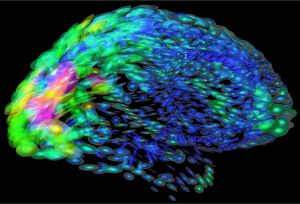Even though this conjecture dates back to the beginnings of neuroscience, there is little empirical evidence supporting it due to the experimental challenges that it presents. A robust mathematical theory that connected complexity and mirror symmetry breaking did not exist either. Seoane, the CSIC researcher at the National Centre for Biotechnology (CNB-CSIC) who developed the model, points out that “until now, research had focused on more mechanistic processes that could also break the symmetry, such as the existence of a dominant hand”. “This new model, based on complex systems science, proves mathematically that the evolution of advanced cognitive functions is a key ingredient that can break the bilaterality”, the scientist says.
Additionally, he comments: “There are cases that progress from a symmetric configuration towards an asymmetric one. For example, babies respond to language with both hemispheres when they are born; but, later on, this function gets lateralized as the brain matures”. The new theory also predicts that in certain situations the mechanism could work in the opposite direction. “A greater cognitive complexity could reenact lost symmetries or generate new ones by duplicating existing circuits. The direction in which the mechanism operates depends on the starting point (if symmetry exists, it will tend to break it), and on how much energy a circuit uses and how many mistakes neurons make when operating”, Seoane concludes.
A new tool to evaluate neural circuits
This work has a double scientific relevance. On the one hand, it confirms a long-standing conjecture in the field of neuroscience. On the other, it opens up the possibility of practical applications in neuromedicine, because the theoretical framework allows us to evaluate optimal configurations of brain circuits—whether they should be symmetric or use each hemisphere separately—and whether a suboptimal configuration can affect neural activity or cause pathologies.
The formulas developed could also be applied to other situations in which the cause for asymmetry is simpler and better known. For example, inside their egg, birds have an eye pointing towards the outside and exposed to light, while the other one remains in the dark pointed towards the inside. This constrains their neural networks for vision and determines, in some species, which eye and brain side will dominate when foraging and keeping an eye for predators.
Besides solving mathematically the historical question, Seoane’s work offers a tool to do computations on neural systems regarding the presence or absence of symmetries. Thus, it would be possible to perform rigorous tests on lab measurements that would help us confirm the hypothesis also empirically.
More information
Seoane LF. Optimality pressures towards lateralization of complex brain functions. Physical Review X. 2023,






